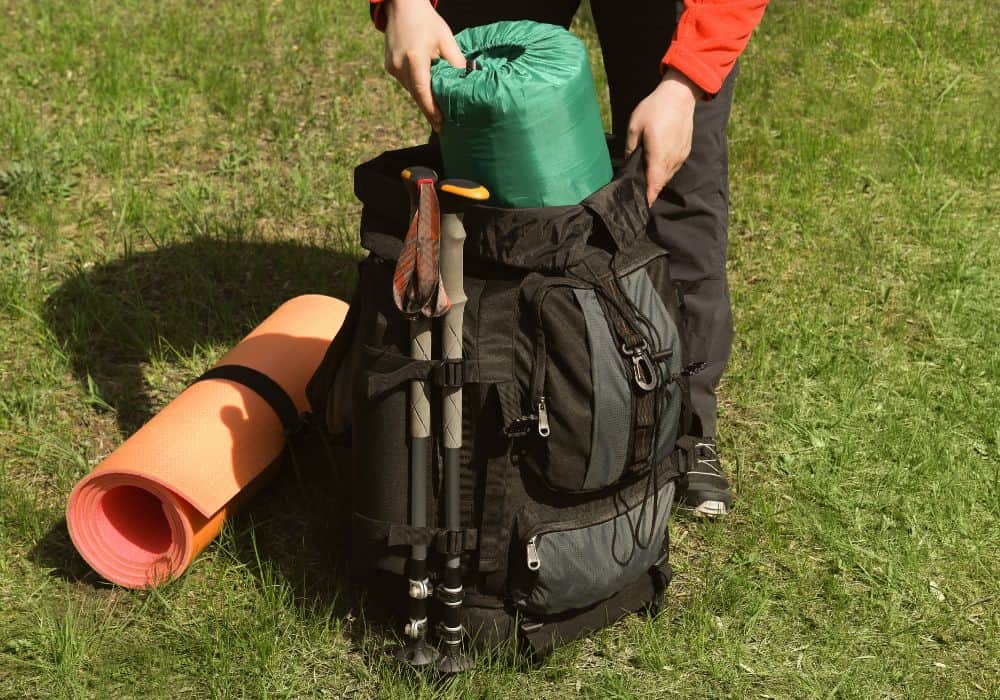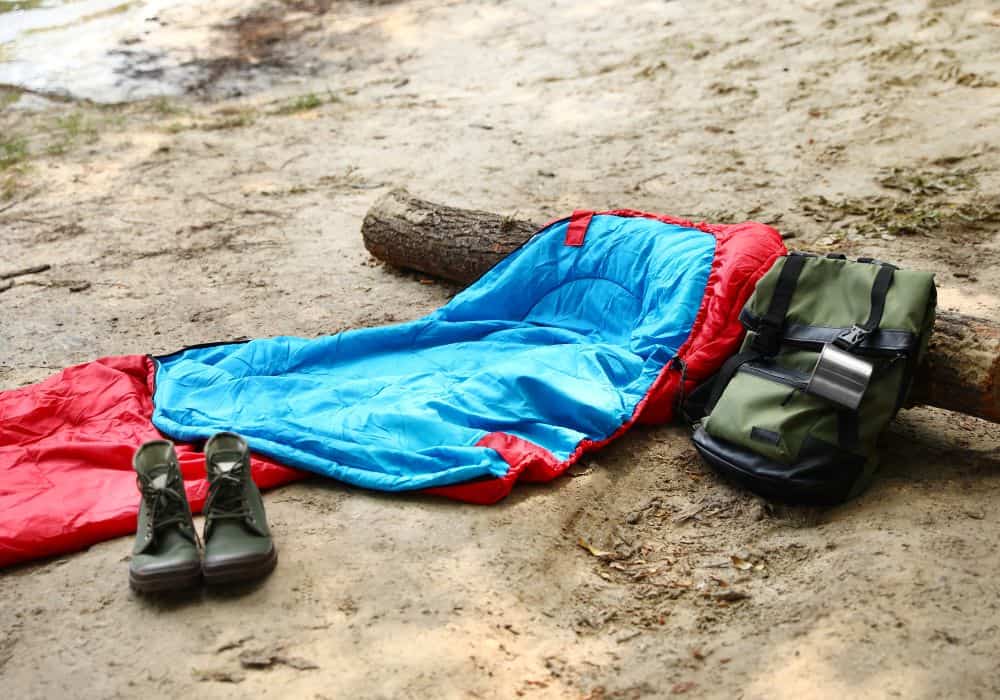How Much Should a Backpacking Sleeping Bag Weigh (2024)
Understanding the Importance of Sleeping Bag Weight
When planning for a backpacking trip, the question often arises – how much should a backpacking sleeping bag weigh?
The weight of a sleeping bag has significant implications on the overall backpack weight, and more importantly, on the hiking experience.
A lightweight design puts less strain on the body during long treks and makes for a more comfortable hike.
But it’s not only about carrying less weight; the best sleeping bag weight also depends on factors such as insulation type, size, shape, and personal comfort level.

Finding the right balance between weight and comfort can enhance your backpacking experience profoundly.
While a light sleeping bag might be easier to carry, it should also provide adequate warmth and sufficient room to rest comfortably after a tiring day on the trail.
Therefore, understanding how much a backpacking sleeping bag should weigh is crucial in selecting the most suitable gear for your adventure.
It’s all about finding that sweet spot between weight, warmth, and comfort to optimize your backpacking experience.
Factors Influencing the Weight of a Backpacking Sleeping Bag
Several components come into play when determining the weight of a backpacking sleeping bag.
The most crucial of these components is the choice of fabric that primarily constitutes the bag. Depending on the material used, such as nylon, polyester, or silk, the weight can significantly fluctuate.
Moreover, the type of insulation – whether it is down or synthetic, further influences the overall heft of the sleeping bag.
Down is lighter and compresses well, but when wet, it loses its insulating properties. On the flipside, synthetic insulation weighs slightly more but performs better in damp conditions.
Another significant factor is the temperature rating of the sleeping bag, which inevitably affects its weight.
Lower temperature-rated sleeping bags use more insulation, and thus are heavier; conversely, bags rated for higher temperatures use less insulation and are lighter.
The construction method is another key factor that adds to the bag’s weight. Higher-end sleeping bags use baffle construction that incorporates extra fabric, adding to the weight, while lower-end models that use simpler stitching methods weigh less.
Additional features such as zips, hoods, and draft collars also feed into the overall weight calculation.
The Role of Material in Determining Sleeping Bag Weight
The weight of a sleeping bag largely depends on the material used in its construction. Traditional sleeping bags are generally made from synthetic materials such as polyester, which is designed to provide warmth and durability.
These materials, while extremely hardy and able to withstand some of the most adverse weather conditions, can add significant weight to your backpacking gear.
Although their robust nature is appreciated, the added ounces can become burdensome particularly on long hikes.

However, the outdoor industry is not stagnant, and over time, innovative materials such as ultra-light down and high-tech synthetics like PrimaLoft have emerged. These materials offer an unparalleled combination of warmth, lightness, and compressibility.
High-end down material, while flaunting its feather-light attributes, also offers a superior warmth to weight ratio compared to its synthetic counterpart.
These materials are ideal applications for sleeping bag construction, offering an opportune solution for minimizing weight on extensive hiking expeditions.
It should be noted, though, that material is not the only factor to consider when evaluating the weight of a sleeping bag. The design, size, and additional features are also significant considerations.
Impact of Temperature Rating on Sleeping Bag Weight
One of the crucial factors determining the weight of a sleeping bag is its temperature rating. The temperature rating essentially refers to the lowest temperature at which the sleeping bag can keep you comfortable and warm.
Bags designed for colder temperatures are typically heavier as they come with more insulation and thicker materials. Additional layers of insulation not only contribute to a higher weight but also add bulk, making the bag less compact when not in use.

This doesn’t necessarily imply that a lighter sleeping bag is less efficient; it simply means it’s crafted for milder weather conditions.
Thus, if you are planning a summer adventure, you might prefer a lightweight sleeping bag with less insulation, whereas, for winter camping, a heavier, more insulated version would be more appropriate.
Therefore, it’s important to consider the weather conditions you’re likely to encounter when deciding on the weight you’re willing to carry.
The Link Between Size and Weight of a Sleeping Bag
A universal rule in the world of backpacking and camping gear is that size and weight are intricately connected. This rule applies evenly to sleeping bags. Simply put, the larger the sleeping bag, the heavier it tends to be.
Its size encompasses not just the length and width of the bag, but also its thickness. A thicker sleeping bag means more insulation and material which invariably adds to its overall weight.
However, it’s worth noting that advancements in technology and material science have led to the creation of lightweight materials that manage to reduce the weight without compromising the bag’s size or efficiency.

High-grade down, for instance, offers an excellent weight-to-warmth ratio and packs down small, making it a favored choice for lightweight sleeping bags.
Despite these innovations, the fundamental link between size and weight of a sleeping bag remains, presenting users with the ever-present task of carefully balancing their comfort needs with their mobility capabilities.
Considering the Weight of Extra Features in Sleeping Bags
When choosing a sleeping bag, extra features often make a significant difference in overall comfort. Items such as neck baffles, which keep cold air from getting in, or internal stash pockets for storing personal items, can add to the usability and convenience of the bag.
However, these extra features undeniably add to the weight of the sleeping bag. Even lightweight materials such as down feathers or synthetic fiber utilized in creating these features add measurable heft.

Special features like a mummy hood or foot box offer added warmth and can be invaluable in colder environments. Yet, the additional material and insulation used in these areas can increase the weight.
Draft tubes, thermal collars, and zipper guards, while improving the bag’s heat retention capabilities and overall performance in harsh weather conditions, can also contribute to a heavier bag.
Therefore, when considering sleeping bags, it becomes crucial to balance the weight of these comfortable and advantageous specialties with the overall heft and portability.
Reducing Sleeping Bag Weight: The Role of Compression Sacks
Compression sacks, crucial for any backpacking or camping trip, provide an effective solution for reducing the weight of a sleeping bag. Also known as stuff sacks, these versatile tools are specially designed to pack sleeping bags into a compressed size, thus considerably reducing the amount of space they occupy in the backpack.
Not only does this provide extra room for other essential items, but it also significantly lessens the overall weight hikers must bear, making their journey considerably more manageable.

One major advantage of compression sacks is their capacity to accommodate sleeping bags of various sizes, making them an optimal choice for all types of adventures.
While the primary goal of these sacks is to minimize weight, they also protect the sleeping bag from elements like dirt and water, enhancing its longevity.
In other words, utilizing a compression sack contributes significantly to reducing the sleeping bag’s weight, thus aiding in a more comfortable and enjoyable backpacking experience.
Lightweight Vs Heavy Sleeping Bags: A Comparative Analysis
Lightweight and heavy sleeping bags serve different purposes and offer contrasting experiences to backpackers. A lightweight sleeping bag, usually weighing less than 2 pounds, is a coveted choice for long-distance backpackers or those with a minimalist approach.
The subtle weight makes it easier to carry on the trail and reduces the overall load of the backpack. Bespoke materials like down feathers and synthetic technologies contribute to the low weight, providing necessary warmth without burdening the hiker.
On the other hand, heavy sleeping bags offer a snug and warm sleeping solution typically at a more affordable price.
These bags, often weighing between 2 to 5 pounds, incorporate more insulation material, rendering them perfect for chillier conditions. They also tend to provide additional room and comfort features which cater to family campers and casual outdoor enthusiasts.
However, the increased weight could be a drawback for longer expeditions, so the choice between the two depends greatly on a balancing act between comfort, temperature requirements, and the nature of the journey.
The Effect of Sleeping Bag Weight on Backpacking Experience
Whether you’re trekking through the mountains or navigating forest trails, backpacking presents both exhilarating challenges and demands. Among these, managing the weight of your gear, specifically the sleeping bag, is a significant factor that can greatly influence your backpacking experience.
A lightweight sleeping bag can potentially ease your journey, making the traverse through difficult terrains less demanding and more enjoyable. It saves you the strain of carrying extra weight, allowing you to move faster and cover more ground.
Paradoxically, the reduced weight of a sleeping bag should not compromise its essential features, such as insulation, comfort, and durability. A lightweight sleeping bag that lacks adequate insulation could leave you cold and uncomfortable at night, negatively impacting your rest and possibly, your overall experience.
Likewise, the durability of a sleeping bag is essential. Factors such as harsh weather conditions, rough handling, and prolonged use are commonplace in backpacking adventures. Hence, having a lightweight yet robust sleeping bag can ensure a balance between comfort and ease of travel, enhancing your overall backpacking experience.
Importance of Balancing Weight and Comfort in Sleeping Bags
In the world of backpacking, weight and comfort are two factors that hold immense importance when it comes to choosing a sleeping bag.
The weight directly impacts a backpacker’s mobility and energy expenditure. If a sleeping bag is too heavy, it becomes a significant burden to carry, particularly for long distances. It also adds strain to the body and hinders agility, potentially decreasing the overall enjoyment and experience of a trip.
Interestingly, comfort is directly linked to the weight of the sleeping bag as well. Having a sleeping bag that is light enough to carry comfortably but also provides an ample level of warmth and comfort during cold nights is vital.
A sleeping bag is, in essence, a shelter. It should not just be viewed in terms of its weight, but also its ability to provide the necessary insulation and cosiness. After all, getting a good night’s sleep is crucial for sustained energy and spirits on a backpacking trip.
Choosing the Right Weight: Personal Factors to Consider
When it comes to choosing the ideal weight for a sleeping bag, there are several personal factors to consider. Individual comfort levels and physical strength are two key aspects.
If you aren’t used to carrying heavy loads, choosing a lightweight bag would be suitable for you. Remember, the goal is to comfortably carry your gear throughout your trek or hike.
Next on the list is trip duration and the expected weather conditions. If you plan on an extended backpacking trip in cold weather, heavier, more insulated sleeping bags should be considered, despite their weight.
In such situations, the emphasis should be more on survival and comfort during harsh weather than on minimizing weight. Tailoring your gear to your specific needs and circumstances will enhance your overall backpacking experience.
Tips to Minimize the Weight of Your Backpacking Gear
Planning your backpacking adventure requires careful consideration of the gear you carry. It’s crucial to strike a balance between having all the essentials and reducing extra weight to increase your travel comfort.
Before setting off, thoroughly assess your gear and eliminate any items that aren’t essential. Investing in multi-purpose gear can also significantly minimize the weight, as they perform multiple functions, hence reducing the number of items to pack.
When it comes to reducing your backpacking sleeping bag’s weight, several strategies can be employed. Compression sacks can be a game-changer, allowing you to compact your sleeping bag to a smaller size, making more room for other items and helping your pack feel lighter.
Opting for sleeping bags with a higher temperature rating can also save weight, so long as it suits the weather conditions of your camping place. Lastly, consider the material and size of the sleeping bag to make sure you aren’t carrying unnecessary weight.
Case Study: Real-Life Experiences with Different Sleeping Bag Weights
Adventure got a defining edge for Laura, an experienced backpacker, when she decided to explore the Appalachian Trail. Previous trips had taught her that every ounce of gear weight mattered, prompting her to carefully choose her sleeping bag.
She initially opted for an ultralight model weighing just 1 lb 6 oz that pledged satisfactory comfort. Meanwhile, another hiker John, took a different route. He decided to go for a heavier, more robust 3 lb sleeping bag for his trek to Mount Kilimanjaro, a far harsher environment compared to Laura’s hike.
Laura’s journey revealed that the ultralight sleeping bag, despite its low weight, compromised on warmth and comfort. The chill was often unbearable due to its thin insulation, making her nights unpleasant.
Conversely, John’s experience with a heftier sleeping bag in the colder climbs demonstrated the benefits of additional weight. His bag provided ample insulation and warmth, unhindered by the freezing temperatures of Kilimanjaro.
Both experiences underscore that the weight of a sleeping bag needs to be mindfully evaluated, considering not only the physical strain it puts on the hiker but also the level of comfort and warmth it provides.
FAQs
Why is the weight of a sleeping bag important?
The weight of a sleeping bag is crucial because it directly affects the overall weight of your backpack. The lighter the bag, the more comfortable and effortless your backpacking experience will be.
What factors influence the weight of a backpacking sleeping bag?
Several factors influence the weight of a sleeping bag including the type of material used, the temperature rating, the size of the bag, and any additional features or accessories it might have.
How does the material of a sleeping bag determine its weight?
Material plays a significant role in determining sleeping bag weight. For instance, synthetic materials are generally lighter than down or cotton, though they might not offer the same level of warmth and comfort.
How does the temperature rating impact the weight of a sleeping bag?
The temperature rating of a sleeping bag can significantly impact its weight. Bags rated for colder temperatures tend to be heavier due to the additional insulation required to keep the user warm.
What is the relation between the size and weight of a sleeping bag?
The size of a sleeping bag directly affects its weight. Larger bags need more material and insulation, making them heavier compared to smaller bags.
Can I reduce the weight of my sleeping bag?
Yes, using a compression sack can help reduce the volume of your sleeping bag, thereby reducing its weight and making it easier to carry.
What are some personal factors to consider when choosing the weight of a sleeping bag?
Personal factors like your physical strength, endurance levels, the duration and difficulty of your hike, and personal comfort preference should be considered when choosing the weight of your sleeping bag.
Do you have any tips to minimize the weight of my backpacking gear?
Opting for lightweight materials, reducing unnecessary extras, using multipurpose gear, and packing only the essentials can help minimize the weight of your backpacking gear.
Can you share some real-life experiences of using different sleeping bag weights?
While we don’t have any specific experiences to share in this FAQ section, the article provides a detailed case study highlighting real-life experiences with different sleeping bag weights. Please refer to the main article for this information.




